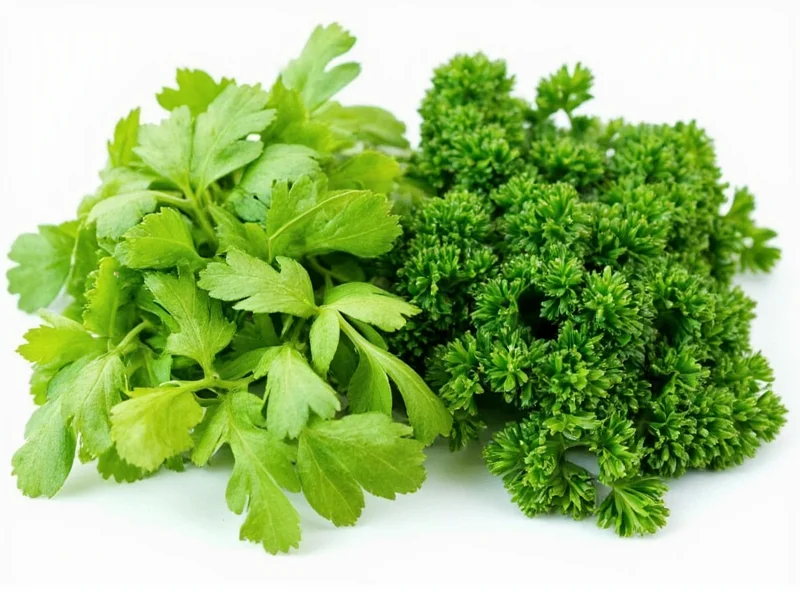Understanding the differences between cilantro and parsley leaves is crucial for home cooks and culinary professionals alike. While these herbs may appear similar at first glance, their flavor profiles, culinary applications, and visual characteristics differ significantly. This comprehensive guide provides the knowledge you need to confidently identify, select, and use each herb appropriately in your cooking.
Visual Identification: Spotting the Differences
Learning how to tell the difference between cilantro and parsley starts with examining their physical characteristics. Though both belong to the Apiaceae family, their leaf structures reveal clear distinctions.
| Characteristic | Cilantro | Parsley |
|---|---|---|
| Leaf Shape | Rounded, lacy edges with asymmetrical lobes | Flat, serrated edges with uniform shape (flat-leaf) or tightly curled (curly) |
| Color | Darker green, sometimes with bronze undertones | Brighter, more vibrant green |
| Stem | More delicate, thinner stems | Sturdier, thicker stems |
| Growth Pattern | Leaves grow in a more open, spreading pattern | Leaves grow in tighter, more compact clusters |
When examining fresh bunches, cilantro leaves typically appear more delicate and rounded, while parsley leaves have sharper, more defined edges. Flat-leaf parsley (also called Italian parsley) bears the closest resemblance to cilantro, making visual identification particularly challenging. Curly parsley is easier to distinguish due to its distinctive ruffled appearance.
Flavor Profiles: Understanding Taste Differences
The most significant difference between cilantro vs parsley leaves lies in their flavor profiles. These distinct tastes dramatically impact how each herb functions in recipes.
Cilantro delivers a bold, citrusy flavor with notes of lemon and sage. However, approximately 21% of the population carries a genetic variation that causes cilantro to taste like soap—a phenomenon known as cilantro aversion. This herb's flavor diminishes quickly when cooked, making it best suited for fresh applications.
Parsley offers a milder, slightly bitter, grassy flavor with subtle peppery notes. Unlike cilantro, parsley maintains its flavor when cooked, making it versatile for both raw and cooked dishes. Flat-leaf parsley has a more robust flavor than its curly counterpart, which tends to be milder and primarily used as a garnish.
Culinary Applications: When to Use Each Herb
Understanding the culinary differences between cilantro and parsley helps prevent recipe disasters. These herbs play distinct roles in global cuisines:
- Cilantro: Essential in Mexican salsas, guacamole, and ceviche; Indian chutneys and curries; Southeast Asian noodle dishes and salads; Middle Eastern tabbouleh and zhug
- Parsley: Foundation of French fines herbes; key component in Italian gremolata and salsa verde; traditional in Middle Eastern tabbouleh; common garnish in European cuisines; essential in American clam chowder
Can you substitute parsley for cilantro? While possible in some applications, the substitution dramatically alters the dish's flavor profile. Cilantro's distinctive citrus notes cannot be replicated by parsley. In emergencies, use half the amount of parsley plus a squeeze of lime to approximate cilantro's flavor, but recognize the dish will differ significantly from the original.
Nutritional Comparison: Health Benefits
Both herbs offer impressive nutritional profiles, though with some key differences that might influence your choice based on dietary needs.
| Nutrient (per 1/4 cup) | Cilantro | Parsley |
|---|---|---|
| Vitamin K | 23% of daily value | 241% of daily value |
| Vitamin C | 3% of daily value | 18% of daily value |
| Vitamin A | 2% of daily value | 16% of daily value |
| Antioxidants | Rich in quercetin and terpenes | Higher in flavonoids and apigenin |
| Unique Benefits | Natural detoxifier; may help lower blood sugar | Excellent for bone health; may reduce inflammation |
While both herbs provide valuable nutrients, parsley significantly outperforms cilantro in vitamin K content, crucial for blood clotting and bone health. Cilantro contains unique compounds that may help remove heavy metals from the body. Both contribute to overall antioxidant intake, supporting cellular health.
Growing and Storage Tips
Proper storage extends the life of both herbs, but their requirements differ slightly due to their botanical characteristics.
Cilantro is notoriously difficult to keep fresh. To maximize its shelf life:
- Trim stems and place in a glass of water like flowers
- Cover loosely with a plastic bag
- Store in refrigerator for 7-10 days
- Freeze chopped leaves in ice cube trays with water or oil for longer storage
Parsley proves more resilient:
- Wrap in slightly damp paper towel and store in produce drawer
- Alternatively, store upright in water with a loose plastic bag cover
- Typically lasts 1-2 weeks refrigerated
- Dries well for long-term storage
When growing your own, cilantro prefers cooler temperatures and bolts (goes to seed) quickly in heat, while parsley tolerates a wider temperature range and has a longer productive season.
Common Mistakes and Practical Tips
Even experienced cooks sometimes confuse these herbs. Here are practical identification tips to prevent culinary mishaps:
- Smell test: Crush a leaf between your fingers—cilantro emits a strong citrus aroma, while parsley has a more subtle, grassy scent
- Stem examination: Cilantro stems are more delicate and hollow, while parsley stems are sturdier and solid
- Leaf vein pattern: Cilantro leaves have more irregular, asymmetrical veins; parsley veins form a more uniform pattern
- Seasonal availability: Cilantro is more commonly found year-round in grocery stores, while parsley (especially flat-leaf) may be seasonal in some regions
When recipes call for "fresh herbs" without specification, consider the cuisine: Mexican, Indian, or Thai dishes almost certainly require cilantro, while Italian, French, or American dishes typically use parsley.











 浙公网安备
33010002000092号
浙公网安备
33010002000092号 浙B2-20120091-4
浙B2-20120091-4